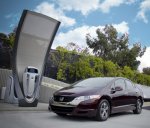Late in January, Honda commenced operations of another solar hydrogen station prototype at the Los Angeles Center of Honda R&D Americas, Inc. Honda’s forays into solar hydrogen solutions has among its goals the development of a feasible home refuelling station.
Honda’s latest creation is smaller than previous prototypes, but produces enough hydrogen (0.5kg) for daily commuting; around 16,000 kilometres a year.
Honda engineers were able to eliminate the compressor entirely in their latest version, representing a world first for hydrogen refuelling systems designed for the home market. This also meant other key components could be smaller, while improving system efficiency by more than 25% compared to the solar hydrogen station system it replaces.
Honda says their Solar Hydrogen Station would enable users to refill their vehicle slowly overnight. So how is this achieved given the sun doesn’t shine at night?
During daytime peak power times, the Solar Hydrogen Station can export renewable electricity to the grid, providing a cost benefit to the customer. At night time, the system would work on off peak power via the mains grid. While this system would be energy neutral; to be carbon neutral, the off peak power supplied would need to be sourced from renewable sources, such as wind farms.
In terms of the number of solar panels needed to power such a system to achieve energy neutrality – it’s by no means a small system. The new Solar Hydrogen Station uses a 48-panel, 6.0kW solar array. The average sized residential solar power system in Australia is around 1.5kW and for the average Australian family to have all their household electricity needs met by solar power; a system of around 4kW capacity would be required. However, Honda’s latest Solar Hydrogen Station is just a prototype and through continued development should see efficiencies improve and therefore panel requirements decreased.
The array utilizes thin film solar cells composed of copper, indium, gallium and selenium (CIGS) produced by Honda Soltec Co., Inc. Honda says its unique solar cells reduce the amount of CO2 generated during production as compared to conventional solar cells.
Honda says the combination of a fuel cell electric vehicle and the solar hydrogen station could help lead to the establishment of a hydrogen society based on renewable energy, resulting in a major reduction of CO2 emissions and greater energy sustainability.












































